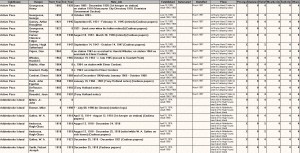Kerosene to Electricity
In the early days of lighthouses all lighting was by kerosene lamps with wicks or mantles.

When electricity first came to the lights it was only for running the main light and occasionally for operation of the foghorn solenoids. Sometimes a knowledgeable principal keeper would wire in a light to his house – a single cable hanging from the ceiling with a small wattage bulb – usually in the kitchen.
Later came large generators and a bit more power. I say a bit more. My first lightstation at Pulteney Point had a 5 KW Kato generator run by a two-cylinder Lister diesel engine which supplied power to the main light, radio, and foghorn controls. The rest was left to be split between the three keeper’s houses. In 1969 our house was only one year old but had one electrical outlet per room and only two fused circuits per house, which of course ran the lights and electrical outlets. Continue reading What You Take For Granted – Electricity, Water, Heating






